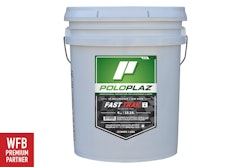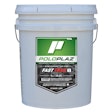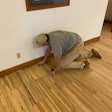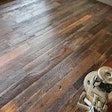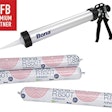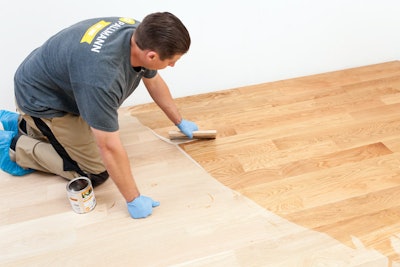
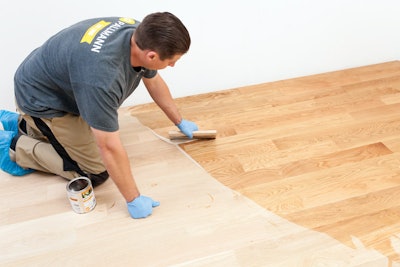 The steel trowel application method allows the contractor to push the oil deep into the wood fibers, yet is flexible enough to cut in the edges of the working area.
The steel trowel application method allows the contractor to push the oil deep into the wood fibers, yet is flexible enough to cut in the edges of the working area.
There has been a lot of buzz in the hardwood flooring industry lately regarding natural penetrating oil finishes. Their popularity has increased due to new color schemes by prefinished flooring manufacturers, as well as the low-sheen or matte look desired by homeowners. Here are some key things to know about natural penetrating oil finishes that can help guide you through your first project.
Key attributes
Natural penetrating oil finishes differ from traditional surface-build finishes in that they gain their strength by penetrating into the fibers of a wood floor and strengthening them, as opposed to gaining strength by sitting on top of the wood floor through the application of multiple layers. A natural penetrating oil finish hardens and protects the floor from spills, traffic and general living on the floor when fully cured. Similar to traditional surface finishes, in the natural penetrating oil finish category there are single-component and two-component finishes.
There are three key attributes that tend to guide contractors toward using a natural penetrating oil finish. The first is the look, which includes color, and feel of the finish when dry. Natural penetrating oil finishes tend to produce a velvety warm feel with a matte appearance. This is especially popular in wide-plank installations, and many designers are pushing low-sheen appearances for wood flooring. Contractors have also mentioned that having two-tone color combinations—when one color is applied and allowed to fully cure, then a second color is applied over the top—is another reason they choose a natural penetrating oil. This process mimics what homeowners find in many prefinished wood flooring lines. If the exact color a homeowner is looking for cannot be achieved using only natural penetrating oil, some natural penetrating oil finishes can be applied over a dried solvent-based or water-based stain to achieve a perfect color match.
A second attribute contractors find helpful in this finish category is the repairability of the product after installation. Due to the diffusive nature of natural penetrating oils, repairs that would be complete screen and recoats with a surface finish can now be simple repairs involving board replacement and buffing of the affected area to blend back into the floor. This process saves money, countless man-hours moving furniture, and screening and coating a floor.
A third key attribute most contractors look at when using natural penetrating oil finishes is their “green” aspect. Homeowners are doing their research and realizing the VOCs of many natural penetrating oil finishes are extremely low—much lower than most waterborne finishes. This allows many natural penetrating oil finishes to be used in LEED-certified projects and help environmentally conscious homeowners make an easy decision.
Application essentials
 Homeowners and designers are incorporating natural penetrating oils into projects for their low-sheen matte appearance.
Homeowners and designers are incorporating natural penetrating oils into projects for their low-sheen matte appearance.
The application process of each natural penetrating oil finish varies from manufacturer to manufacturer. As a general rule of thumb, it is important to not sand the floor too fine. A contractor should stop sanding with the big machine at 80–100 grit, and sand no finer than 120 grit with the buffer. If the floor is sanded too fine, this can cause the finish not to penetrate into the wood fibers and leave excess oil on the surface of the floor. This will result in a poorly performing finish, which could lead to premature wear and less chemical resistance. Water-popping is also a helpful technique to ensure deeper penetration of the finish into the wood floor for maximum protection.
When beginning to work with natural penetrating oil finishes, it is important to work in small sections. Natural penetrating oil finishes generally have a limited working time during which they need to be buffed off before they begin to dry. If the working time limit is exceeded, this can create difficulties in removing the excess oil. Working in small sections should allow the contractor to apply and remove the oil on the floor in a comfortable timeframe.
Application tools vary for each manufacturer of natural penetrating oil finishes, but one common tool is the steel trowel. It allows the contractor to push the oil deep into the wood fibers and is flexible enough to cut in the edges of the room. Buffing the initial coat of oil onto the wood floor may also be done, typically using a red buffing pad. These pads allow for enough abrasive material to push the oil into the floor, or, for removal of the oil, allows for enough product to be saturated into the pad for pick-up. A white polishing pad works the best for final removal of any excess oil. Rags should be avoided when picking up excess oil, as they do not completely remove all excess oil and tend to leave a slight film on the floor. It is extremely important to make sure all excess oil is removed from the floor. Failure to do this will result in a poorly performing floor. A general rule of thumb when using natural penetrating oil is “less is more.”
Critical factor: maintenance
Maintenance is the most important topic in this category, yet often the most overlooked. Natural penetrating oil finishes require a bit more maintenance than traditional surface-build finishes. In a residential situation (and more frequently in heavy traffic areas), typically once or twice a year a maintenance product must be applied to restore the luster of the natural penetrating oil finish to its original form. Every wood flooring project will vary and require different levels of preventive maintenance. Always consult the manufacturer’s recommended maintenance procedures before beginning your project. It is extremely important to make sure the homeowner understands the maintenance of their floor prior to applying a natural penetrating oil finish. A common complaint with natural penetrating oil finishes is the failure of understanding the maintenance procedures involved, which often leads to poor customer experiences in this finish category. The natural penetrating oil finish category is a growing segment in the finish industry. There are many key advantages to this type of finish over traditional surface-build finishes, yet this finish type is not for every homeowner. When discussing this type of finish with a homeowner, it is important to keep in mind their lifestyle and needs in a wood floor finish. If a natural penetrating oil finish appears to be a fit for your next project, follow the guidelines presented above and you will have a beautiful project to showcase.
This article was paid for by Pallmann, where Josh Neuberger is marketing manager. Pallmann can be contacted at [email protected] or www.pallmann.us.















